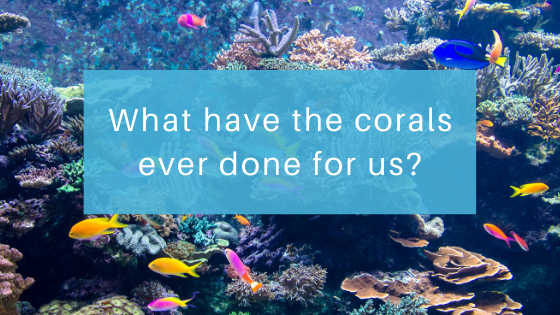If you’ve been watching David Attenborough’s Seven Worlds One Planet, you’ll have seen the coverage of the grey reef shark during the Australia episode, a rare species of shark that likes the shallow and warm conditions of, you’ve guessed it; coral reefs. But Attenborough warned that with the disappearance of reefs, such as Australia’s infamous Great Barrier Reef, we may lose out on our chance to study these elusive animals.
You may well be thinking, well, that’s sad for shark science, but what else are coral reefs actually good for? Well, good news, in today’s post we’re going to dive right into coral reef science and explore what the coral reefs actually do for the planet, and why we should be worried about their current situation.
What are corals?

Corals are invertebrates that exist as polyps; soft-bodied creatures, similar to jellyfish or sea anemones. Reefs are formed when one of these polyps binds itself to a rock on the seafloor and begins dividing itself to form several clones. They build limestone skeletons out of calcium and carbon in seawater, and usually only emerge from these skeletons at night, releasing tentacles to feed, often on plankton, but occasionally even small fish.
Corals get their colour from their symbiotic zooxanthellae algae – the coral provides the algae with shelter, plus some of the materials they need to photosynthesis, whilst the algae offer the coral oxygen, waste removal, and the products of photosynthesis, including amino acids and glucose. Bleaching occurs when factors such as increases in sea temperature or acidity cause the loss of a coral’s algae, hence the loss of colour, as well as all the benefits conferred by the zooxanthellae algae.
Coral reefs are complex
Coral reefs are such biodiversity hotspots because of the complexity of their structure. Often known as the ‘rainforests of the sea’, reefs form in shallow coastline waters, and provide habitats (and oxygen) for a huge number of animals, from crustaceans to turtles, marine mammals to molluscs, and lots more in between. Coral reefs also act as carbon sinks, in much the same way as trees do – storing carbon in their limestone skeletons, preventing it from being released into the atmosphere and acting as a greenhouse gas, hence, they are hugely important for the health of the planet.
Because of the interwoven nature of corals in reefs, they also provide natural barricades which protect shorelines from sea erosion and damage from storms, by dispersing waves and accumulating sand. It is estimated that over 150,000km of coastline in 100 countries receive protection from coral reefs. Without reefs, coastal buildings and homes are much more vulnerable to wave and storm damage, and with extreme weather events such as storms and tsunamis on the rise due to climate change, these natural blockades are becoming more and more precious. The residents of the Maldives found this out the hard way when, after coral rock was mined away from shorelines for construction purposes, a wall needed to be built to protect the coast, costing $10 million per kilometre to build.
Coral reefs provide the main food source of approximately 1 billion people in Asia alone, and estimates suggest that around 25% of total fish catch in developing countries worldwide originate from coral reefs. Annually, reefs are worth $6.8 million to the fishing industry, with each square kilometre of coral reef producing, on average, five tonnes of seafood, a total of 1.42 tonnes per year from coral reefs!
The global value of reefs is estimated at around $9.9 trillion, with reefs bringing in money not only from fishing, but also via tourism, and the creation of jobs needed to support the ecotourism industry, including hotels, restaurants, and diving schools. Coral-tourism generates approximately $36 billion for host countries per year, supporting 6.5 million jobs.

What’s the outlook for coral reefs?
As mentioned above, coral reefs face huge threats from climate change, with rising ocean temperatures causing bleaching, and the subsequent loss of their symbiotic algae which they rely on for food sources and oxygen.
The consequences of bleaching events can be long-lasting, as recovery often changes in the reef composition as coral communities rebuild themselves, leading to problems for other species, such as habitat fragmentation, and the migration of species to other locations, in turn, affecting the established food chains of the reefs.
By 2016, the world had lost half of its coral reefs, and UNESCO reports that this figure will rise to 90% by 2050. The result of losing so much of the world’s coral would be disastrous, from the loss of habitats and coastal protection to the collapse of the reef-based recreation industry upon which many people depend for their livelihoods.
But it’s not just global warming causing problems for corals; ingredients in many products such as sunscreen, cosmetics and fragrances can also be damaging to reefs. Research has demonstrated that oxybenzone, or BP-3, a UV blocker, which is found in over 3,500 skincare related products, enters the marine environment either directly from swimmers’ skin, or via wastewater, and can wreak havoc on young corals. DNA damage and abnormal skeletal growth are some of the problems that oxybenzone can produce for juvenile coral, hence, the development of non-toxic alternative UV protection, as well as ensuring removal of the chemical during wastewater processing, is crucial to ensure new coral can grow and survive in conditions that are already challenging enough.

It’s clear that corals are facing an uncertain future, threatened with pollutants, climate change and overexploitation, but we hope we’ve at least convinced you that they are worth fighting for. A world without coral reefs is a world devoid of marine life, with coastlines vulnerable to extreme weather events, and economies demolished, so help spread the word and let’s make sure the coral reefs are not forgotten in the discussion around climate change.




